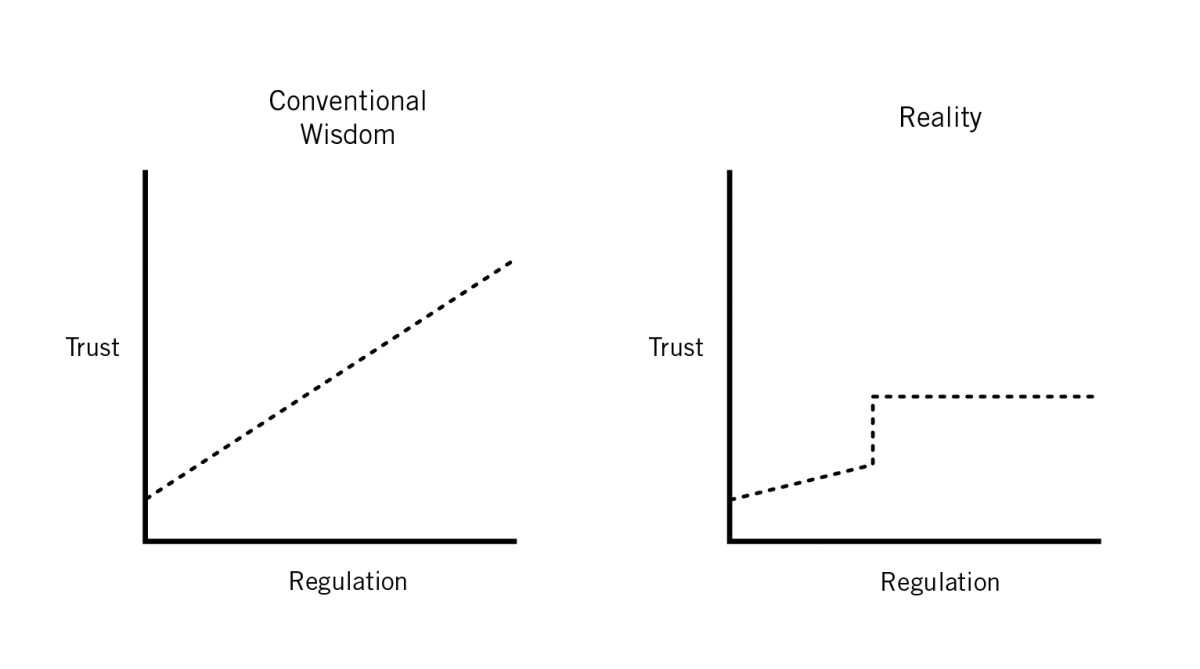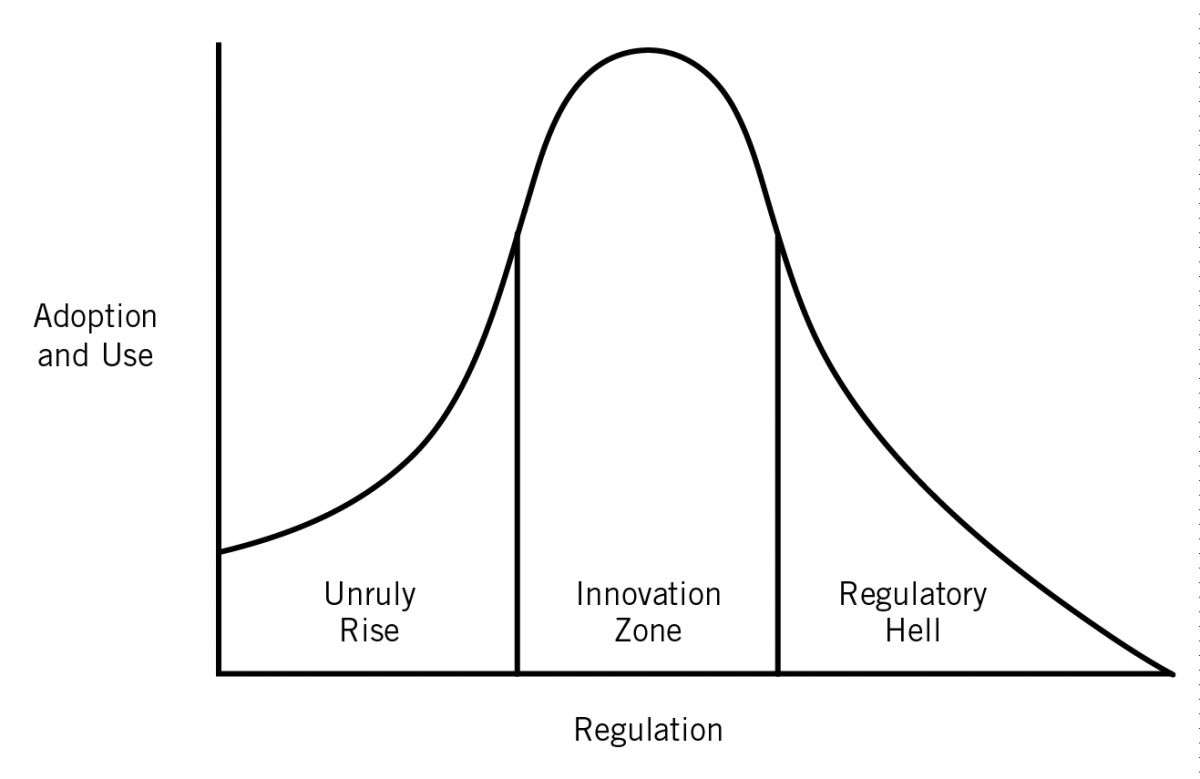Why Stronger Privacy Regulations Do Not Spur Increased Internet Use
Data protection regulations are often falsely described as means to increase consumer trust, and therefore technology adoption and use. Policymakers should be wary of those making this claim without evidence.
Over the last two decades, it has become the conventional wisdom in tech policy circles that stronger privacy regulations increase consumer trust, and higher levels of consumer trust will lead to more technology use. Few observers who should know better have challenged this assumption, and now many who influence policy simply assert it without question. However, there is little evidence to suggest that beyond some minimum baseline of consumer protection, stronger privacy regulations increase trust, adoption, or use. On the contrary, additional regulation restricts the supply of digital technologies by raising costs and reducing revenues for companies to invest in new products and services. In short, the conventional wisdom about the connection between regulation and trust is wrong. Policymakers should reject proposals purporting to increase trust through greater regulation of the digital economy if they come at the expense of innovation and consumer welfare.
Most activities—from bicycling to mountain climbing—involve some level of risk. Often, the individuals engaged in these pursuits cannot control all of the risks themselves. This is where trust comes in. For example, bicyclists may trust that their helmets work properly, and mountain climbers may trust that their ropes will not break. In the context of technology, trust is the level of certainty an individual has in the risk, or lack thereof, involved in using a given technology based on their experiences and expectations. The likelihood that individuals will use a particular technology is a function of the value they perceive in using the technology and their level of trust.
Many policymakers have called for policies to increase consumer trust in digital technologies and platforms, justifying increased regulation on the grounds that it will boost digital adoption. For example, in the United States, the Clinton, Bush, and Obama administrations each cited the importance of building trust in boosting adoption and use of the Internet, e-government applications, and the Internet of Things, respectively. The European Union has also invoked increasing trust as a justification for numerous data protection regulations, including its new General Data Protection Regulation (GDPR). And most privacy advocates have justified their calls for stricter privacy laws on the grounds that they boost trust, which in turn boosts digital technology usage.
In this framing, the relationships between trust and regulation as well as between regulation and technology adoption and use are linear: More regulation leads to more trust, and more trust produces more adoption and use. Therefore, stricter privacy regulations will boost adoption and use—regardless of baseline levels of regulation that already exist. For policymakers considering regulation, this is the proverbial free lunch: The more regulations they create, the larger the economic benefits they will reap. In fact, however, the relationship between trust and regulation is likely not linear. To continue the analogy from above, mandating that bicycle helmets be able to withstand a three-meter fall onto an anvil—the current standard is two meters—would be unlikely to increase trust in cycling, because the existing standard already protects against most common accidents. As such, there is some level of regulation beyond which further protection has little effect on trust. Therefore, the relationship between regulation and trust is a stepwise function: No regulation can mean very little trust and some reasonable baseline level of regulation increases trust, but trust does not measurably increase beyond that baseline level (see figure 1).
Figure 1: Linear versus stepwise relationship for trust and regulation.

Even if strengthening data privacy rules beyond some baseline level does not increase trust, what would be wrong with enacting additional rules? In other words, if a three-meter fall standard would provide even a modicum of greater bicycle safety than the current two-meter standard, why not simply mandate the higher standard? The answer is the same for all regulatory decisions: to balance costs with benefits. A three-meter standard would increase the costs of helmets, thereby reducing consumer welfare by depriving them of money that could be spent on other things, and perhaps even hurt safety, as some consumers would forgo the purchase of these more expensive helmets and ride without
one altogether.
Stringent data protection regulations are the digital equivalent of the three-meter helmet standard. More stringent rules raise compliance costs and reduce advertising revenues for companies that provide online services. And higher costs with lower revenues reduces the investments companies can make to improve their services. For example, one reason there are relatively few high-quality, ad-supported websites and apps for children in the United States is that the U.S. Congress has enacted strict privacy laws that limit the viability of these services. While baseline protections may have a modest effect in increasing the trust people place in digital technologies, past a certain point, stronger data protection regulations usually have the unintended consequence of decreasing the supply of technology. Therefore, rather than describe the relationship between regulation and digital technology adoption and use as linear, it is best described as an inverted U-curve (figure 2).
Figure 2: Linear versus inverted-U relationship for regulation and technology adoption and use.

In this report, we attempt to decipher which is correct, the conventional wisdom or our hypothesis. To achieve this, we analyze three relationships: whether regulation has an effect on trust, whether regulation has an effect on willingness to adopt, and whether regulation has an effect on production and, as a result, usage.
Does Digital Regulation Increase Trust?
First, we use survey evidence to analyze levels of trust across countries with data protection laws and enforcement of various levels of strength. Our analysis suggests that strong data protections regulations have little to no positive effect on trust when compared to other countries with moderate or limited levels of digital regulation. This is perhaps because people interpret stringent privacy regulations as a sign the government is telling its citizens the technology cannot be trusted. As a result, this relationship does not appear to be linear.
While we believe that the relationship between digital regulation and trust is likely a stepwise relationship (see bicycle helmet discussion above), there is not enough data or evidence at this time to make a conclusive determination.
Does Digital Regulation Increase Willingness to Adopt Internet Applications?
Second, we used survey data to analyze whether digital regulation actually improves individuals’ willingness to adopt Internet applications in the European Union and United States. This evidence does not suggest increased regulation leads to a greater willingness to adopt, as countries with stronger regulations also have higher percentages of people who claim to avoid using such technologies due to privacy or security concerns.
We conclude that the relationship between regulation and willingness to adopt is not linear. If data protection regulations had a linear relationship with Internet adoption, European respondents would likely have lower levels of privacy or security concerns than their U.S. counterparts due to having stricter privacy laws. However, most European and U.S. respondents who do not subscribe to Internet access make that choice for other reasons, such as the lack of a perceived need, insufficient skills, or cost concerns.
Does Digital Regulation Increase Peoples’ Usage of Internet Applications?
Finally, we analyze usage rates for three different technology applications—Internet access, social media, and online shopping—before and after the implementation of a European privacy law. In all three categories, the United States showed higher increases in usage than the European Union, despite having more stringent privacy regulation. We found similar patterns comparing usage rates in the United States to those in France and the United Kingdom. In short, the data show no evidence that implementation of strong data protection rules spurred more people to use technology.
Policymakers Should Strive for a “Goldilocks Level” of Data Regulation
Proponents of strict data regulation ignore the costs. Companies have to devote resources to compliance, which reduces the amount of money that can be invested in innovation. Moreover, strict privacy regulations reduce the revenue digital companies can earn from online ads, thereby reducing the overall growth of the digital ecosystem. If digital ad revenue grew at the same rate in Europe as in the United States, then an additional 11.7 billion euros would have flowed into the EU digital ecosystem between 2012 and 2017.
Given the negative effects of overly strict regulation, we conclude that if one of the goals of data protection rules is to increase consumer adoption of online services, then creating rules that add costs and reduce revenues is not the best solution. While baseline protections may have a modest effect in increasing the trust people place in digital technologies, stringent rules not only do not increase trust, they reduce the revenues companies have to develop and improve online services. This reduction in supply of innovative products and services would deprive consumers of the rapidly developing services and technologies that characterize the Internet age.
Our analysis shows that the relationship between regulation and the adoption and use of digital services is best described as an inverted U-curve with three stages (figure 3). In the first stage, which we call the “Unruly Rise,” a lack of protections—either from government or industry practices—may reduce the growth of consumer adoption and use of Internet applications, because consumers may have lower levels of trust. In the second state, the “Innovation Zone,” a reasonable baseline of protections promotes both trust and innovation, thereby ensuring high levels of user adoption and use of Internet applications coupled with a robust digital innovation ecosystem. However, if policymakers create overly restrictive rules, the use of online services will likely fall or grow more slowly than it would otherwise due to a reduction in supply caused by costly and revenue-limiting regulations. This third stage, which we call “Regulatory Hell,” is where overly strict rules can actually harm consumers by creating excessive burdens on digital innovators. After passing the GDPR, the European Union now appears to be descending into the early stages of “Regulatory Hell.”
Figure 3: Inverted U-curve showing relationship between regulation and technology adoption and use.

This relationship suggests that there is an optimal level of regulation—a Goldilocks level—of rules that are neither too weak nor too strong. Too little regulation is problematic as it does not provide baseline protections that encourage consumer trust. But overly restrictive regulations are not only unlikely to increase consumer trust, they actually reduce the ability of companies to innovate or provide free or low-cost services, which in turn results in a reduced supply of technologies and constrains a nation’s overall Internet ecosystem.
It is time, therefore, to end the spurious claims that more privacy regulation is pro-innovation and pro-consumer. Policymakers should strive to achieve the right balance between legitimate privacy and security concerns on the one hand and innovation on the other by employing a three-part test for data protection regulations: First, they should target specific, substantial harms. Second, they should directly limit those harms. Third, the costs of the regulations must be outweighed by their countervailing benefits.

